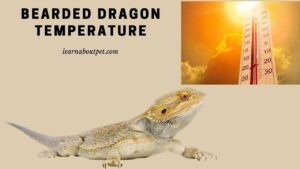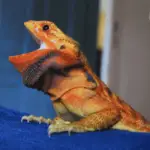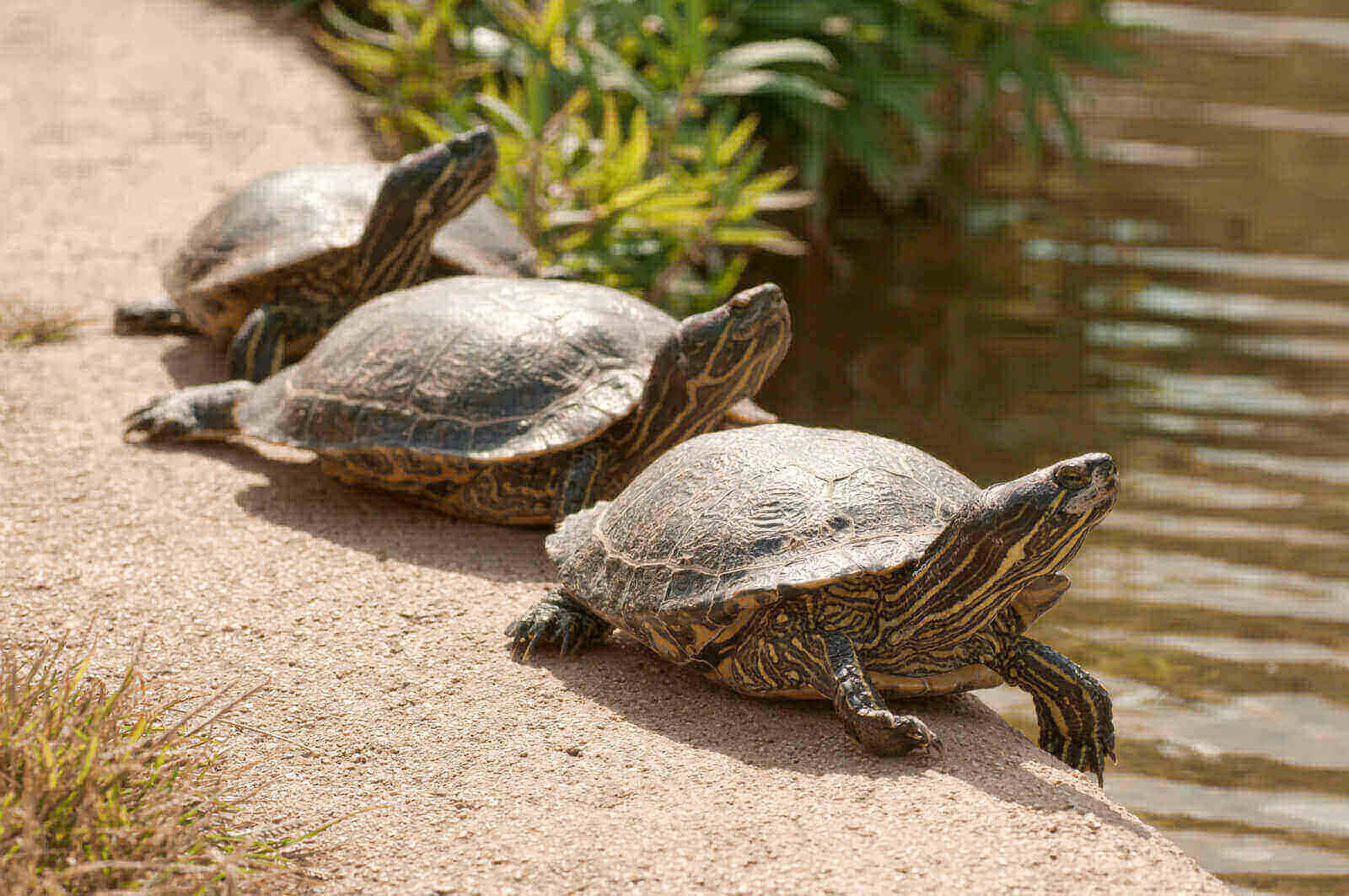Breaded dragons are quite a favorite pet in the lizard category. Fairly easy to maintain and intelligent enough to learn many tricks and commands. They are cold-blooded animals and love to bask in the sun to maintain body temperature for their metabolic system.
The best body temperature for the body of the bearded dragon is 93 – 95°Fahrenheit (34 – 35°Celsius). The bearded dragon’s enclosure should be large enough, so a soft thermal gradient between the warm side and cool side is easily achieved.
In this write up we discuss the bearded dragon temperature, basking temperature for bearded dragons, baby bearded dragon basking temp, and many more related queries.

Hope you enjoy the read and will give us feedback. We shall be happy to answer your queries.
What Is The Ideal Temperature For A Bearded Dragon?
People frequently ask what temp should my bearded dragon tank be. The bearded dragon is a cold-blooded lizard, meaning it cannot regulate its body temperature by its metabolism. As a result the bearded dragon body temperature changes with the ambient temperature.
In the wild, they bask in the sun and absorb heat and ultraviolet light (UV) from rocks and wood which have been heated by the sun.
In captivity, it is the caregiver’s responsibility to provide similar conditions as those found in the wild, so the pet is not stressed. Poor temperature controls can give serious health issues.
It is important for the body to be at a particular temperature to have the best metabolism and help in the digestion of the food and the function of different organs.
Bearded dragons are diurnal lizards. That means they get up with the sunrise and are very active during the day and with sundown will go to sleep in their hide.
To provide the bearded dragons comfort in captivity, it is important to provide a similar environment as they get in nature.
Scientists studying the bearded dragon temperature have come up with temperature figures for the baby, juvenile, and adult bearded dragon. Further, there are temperatures for the basking and cool nighttime.
The ideal day and night bearded dragon temperature celsius range is 29 to 21 degrees.
Basking And Cool Areas Of Terrarium
The basking area replicates their natural sun-basking time. This is achieved by appropriate UVA and UVB type lamps, located strategically to provide the right amount of heat at the right distance, where the bearded dragon will lie.
Basking is done for about 12 to 14 hours per day in summers and less about 8 hours in fall and winters. The cool or nighttime temperatures are a must for the comfort of the pet.
It is important that the terrarium is large enough, so a gradual temperature gradient is achieved from the high (basking) area to the cool night area.
The basking and cool areas are on each end of the terrarium. This gives an opportunity to the beaded dragon to find a suitable temperature zone of its liking and need.
The below tables answer the question of how hot should a bearded dragon tank be? And what the bearded dragon cool side temp is. Ideal temperatures for each age group are shown here.
Baby Bearded Dragon Temperature Range
Special thoughts should be given to the baby bearded dragon temperature maintenance, as they are more sensitive to temperatures.
| Area | Ideal Temp. Range |
| Basking area | 95 – 110 °F (35 – 43 °C) |
| Cool area | 80 – 90 °F (27 – 32 °C) |
Juvenile Bearded Dragon Temperature Range
| Area | Ideal Temp. Range |
| Basking area | 95 – 105 °F (35 – 42 °C) |
| Cool area | 80 – 90 °F (27 – 32 °C) |
Adult Bearded Dragon Temperature Range
| Area | Ideal Temp. Range |
| Basking area | 88 – 100 °F (31 – 38 °C) |
| Cool area | 75 – 85 °F (24 – 29 °C) |
Night Time Temperatures
It is recommended to drop the temperatures at night (switch off the basking and daylights) and use heat lamps only to maintain a constant temperature of 70 to 75 °F (21 to 24 °C). This is for all bearded dragon age groups.
How Hot Is Too Hot For Bearded Dragons?
The warmest bearded dragon temperature is the bearded dragon basking temperature which is in the range of 88 – 110 °F (31 – 43 °C). The higher range is for the baby bearded dragons. For an adult, the high range is about 100°F (38°C).
To know if the basking spot temp for bearded dragon is ok, check when the bearded dragon is basking in a pancake position, breathing with an open mouth.
It means it has attained the right temperature. The open mouth shows it is dissipating extra heat and maintaining body temperature.
How Cold Is Too Cold For A Bearded Dragon?
The lowest normal bearded dragon temperature suggested is 65°F (18°C). It can go down to 60°F (≈15°C) for short period, like during the night from which the beardie will recover.
The right temperature is very important for the bearded dragon’s survival. At the right temperature, its metabolism works properly, and all body organs operate normally.
With lover bearded dragon temperature the digestion system will stop and the beardie will have impaction, which could result in its death.
People query what happens if a bearded dragon gets too cold. For prolong low temperatures the bearded dragon will slow down its movement and may become completely still at one point to conserve energy.
In fact, for brumating a bearded dragon the ideal day temperature is 68°F (20°C) and night temperature of 60°F (≈15°C) is suggested.
People ask what is the lowest temperature a bearded dragon can survive. 60°F (≈15°C) is the normal lower temperature for a bearded dragon to revive without an injury.
Is 115 Degrees Too Hot For Bearded Dragon?
In the adult bearded dragon temperature range, 115°F (46°C) is generally considered the highest permissible safe limit for the bearded dragon basking temperature.
110°F is normally considered the baby bearded dragon temperature for basking.
Some pet owners report their bearded dragon basking temperature at a maximum of 125°F (52°C), but then provide a cooler area of around 78 – 80°F (26 – 27°C) in their tank.
This way their bearded dragon has a choice of moving to a cooler place if it feels too hot under the basking lamp.
A gradual temperature gradient is required here. This means the tank should be large enough (horizontally) to have a gradual temperature drop from the hot to a cool area.
Should I Cover My Bearded Dragon’s Cage At Night?
Bearded dragons are diurnal lizards. Meaning they are active during the day and rest or sleep during the night. It is ok if at night their cage is covered, to cut off unwanted light and distraction.

This is not a necessity, as many pet owners report watching late-night TV with their beardies.
If their cage is covered for the night, make sure it is removed first thing in the morning (at sunrise) and assure the right temperatures are maintained during the night.
Should I Turn My Bearded Dragons Heat Off At Night?
In the natural habitat at night, there are no lights, heat, and temperatures drop. In captivity, we must provide similar environmental conditions for the pet bearded dragon temperature at night.
There is no need for lamps, UV or illumination, and basking heating at night.
However, care must the taken to maintain the minimum night temperature recommended for the vivarium, so a comfortable temperature for bearded dragon is maintained for the night.
Can A Bearded Dragon Die From Overheating?
Pet owners are quite concerned to know the importance of bearded dragon temperature and are eager to know can bearded dragons die from too much heat.
Bearded dragon temperature overheating can actually kill it very easily in captivity. In nature, it will have many options to do. Like go and hide, but in captivity poor fellow has nowhere to go.
Pet owners naturally want to know what the bearded dragon overheating symptoms are, so they can take action to relieve their loved one from the heat stress.
A bearded dragon temperature too hot will quickly result in losing body water, the beardie will be confused and heat stroke will result in the death of the beardie.
The signs of a bearded dragon too hot are bearded dragon panting, trying to escape the tank, digging, hiding, and bearded dragon staying on cool side of the tank.
How To Make Bearded Dragon Tank Hotter
In certain cold regions, pet owners ask how to make bearded dragon tank hotter. There are different ways of attaining the bearded dragon temperature and the bearded dragon basking temperature in its tank.
There are ordinary incandescent lamps, ultraviolet ray lamps (UV), ceramic heaters, and LED lights. There are special lights made for the reptiles and lizards’ terrarium. Proper wattage will depend on the size of the tank.
The placement and adjustment of the positions of the light in the tank are important to make it useful for the bearded dragon.
Further, there are regulators and dimmers available to adjust the wattage or output as desired to have better control of the temperature.
A proper commercially designed bearded dragon thermostat setup is available for beardie tanks.
How Long Can A Bearded Dragon Stay In The Sun
In the wild, the bearded dragons can stay in the sun as long as they need to for maintaining bearded dragon temperature. Primarily they need UVB light to make vitamin D, to maintain their metabolism and function of different body organs.
It is not only the sun, their body is absorbing heat from the ground, rocks, and other objects in the surroundings, which are reflecting the heat rays.
They will move to cooler areas when they have attained the heat. They like to enjoy the sun for as long as it is out. Which could be 8 to12 hours or so.
In captivity, however, the caregiver is responsible for maintaining the basking temperature for bearded dragon.
If the tank or cage is inside the house then the UV lamps should remain on as long as the sun is out. Only switched off for the night.
Besides the bearded dragon basking spot, the beardie should have the option of a cool area in his tank.
On the other hand, if the idea is to have the bearded dragon outside in the sun during the daytime, check for the ambient temperatures. The temperatures should be in the recommended range.
The beardie should have the option to move to a cooler area in its cage if the bearded dragon basking temp too hot to lie in the sun.
Bearded Dragon Humidity
Besides maintaining the bearded dragon temperature, maintenance of the required humidity in the bearded dragon tank is important.
High humidity and heat bring on the bearded dragon overheating symptoms, which can be fatal for the beardie.
The ideal humidity recommended for the beardie’s tank is 35 % to 40%.
Final Verdict On Bearded Dragon Temperature
Although the bearded dragon is a survivor of the Australian desert outback, in captivity it has been found it is quite sensitive to temperature changes.
An improper bearded dragon temperature range in its tank, or inappropriate bearded dragon basking temperature, soon affects the health of the beardie.

Being cold-blooded, the bearded dragon needs proper body temperature to maintain its metabolism for digesting food and function of its other body organs.
It is important to have proper lamps and heaters in its habitat at home to replicate the natural environment conditions. Assure not to make the bearded dragon basking temp too hot.
Proper tank size and temperature gradient should be maintained for avoiding thermal shock to the beardie.
These guidelines also apply to the baby bearded dragon temperature, as the baby beardie is more sensitive to temperature changes.

Welcome to Learn About Pet. My name is Rajkumar Ravichandran and I love all pets, travel, and amazing food. I write about my passion and personal experience caring for multiple pets in this blog! ❤️
Post Disclaimer
DISCLAIMER: THIS BLOG OR WEBSITE, "Learn About Pet", DOES NOT PROVIDE YOU WITH MEDICAL ADVICE AND IS NOT A SUBSTITUTE FOR MEDICAL ADVICE. ALWAYS GET IN TOUCH WITH YOUR PERSONAL VETERINARIAN AND USE INFORMATION HERE AS GENERAL ADVICE.
The information, including but not limited to, text, graphics, images and other material contained on this website are for informational purposes only. No material on this site is intended to be a substitute for professional veterinary advice, food recommendation, diagnosis, or treatment. Always seek the advice of your veterinarian or other qualified health care provider with any questions you may have regarding a medical condition or for pet food related questions.







